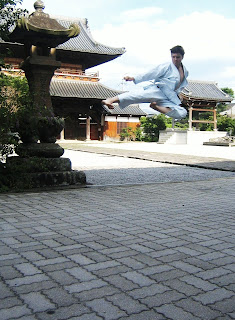 I’ve made many discoveries in recent weeks, which have forced me to change my self-practice routine. I stumbled across several ‘invisible weaknesses’, which I felt extremely compelled to address immediately. Such subtleties are deeply humbling, and are what make Shotokan karate such a wonderful art. To still be a beginner is not a statement of humility, but rather one of neccessity, to stimulate serious ongoing training. This point can never be overemphasized.
I’ve made many discoveries in recent weeks, which have forced me to change my self-practice routine. I stumbled across several ‘invisible weaknesses’, which I felt extremely compelled to address immediately. Such subtleties are deeply humbling, and are what make Shotokan karate such a wonderful art. To still be a beginner is not a statement of humility, but rather one of neccessity, to stimulate serious ongoing training. This point can never be overemphasized.Several things have come to my attention via corrections in the dojo, and my self-practice. Rather than delve into my ‘technical issues’ on here, I’ll avoid boring you to tears, and give you my overall training routine. Whether facing the winter here in the North or enjoying the summer of the Southern Hemisphere, I wish you all the very best in your karate practice. Regardless of where you are, the weather is no excuse not to train! I say this boldly as I type sitting in a warm kotatsu. - André
 KIHON
KIHON1. Yoko-keage in isolation and yoko keage with simultaneous uraken yokomawashi uchi: (a) From kosa aiyumibashi in kiba dachi [ido-kihon style]. (b) From zenkutsu dachi [syllabus style]. (c) Specific yoko keage/uraken yokomawashi uchi from Heian-nidan kata. (c) Specific two yoko keage with uraken yokomawashi uchi from Heian-yondan kata. (d) Specific four yoko keage/uraken yokomawashi uchi from Kanku-Dai kata. (e) Specific four yokokeage/uraken yokomawashi uchi from Gankaku kata. (f) Specific yoko keage with haito uchimawashi uchi from Bassai-Sho kata. (g) Specific two yoko keage with uraken yokomawashi uchi from Kanku-Sho kata. (h) Specific two yoko keage/uraken yokomawashi uchi from Sochin kata.
(2) Gyaku-zuki: Stationary zenkutsu-dachi – ‘grass roots style’ with concentration on refined use of energy (Asai style through and through).
General practice: (3) Mae geri in isolation; (4) Oi-zuki in isolation. And (5) Chudan shuto-uke in isolation. [With all three of these techniques I am reassessing my ‘chambering’ and further ‘person
 alising’ them. I'm also training pelvic hip alignment at a higher level to intensify power on varying angles to my opponent].
alising’ them. I'm also training pelvic hip alignment at a higher level to intensify power on varying angles to my opponent].KATA
For fundamental training, Junro-shodan is my focus. The genius of Tetsuhiko Asai Sensei is so evident in this masterpiece. My advanced training includes Tekki-nidan, Empi, Unsu and Sochin. I've been using Sochin to spice up my routine and to fore mostly address points in my kihon. The depth of Unsu and Sochin, at a high level, is like Freud's Iceberg , so my kata training at present is extremely technical (actually too technical). Such practice cannot be continued for too long by anyone (if they are serious about their development) as it becomes information overload. For the time being, I'll enjoy this for what it is. But I will soon strip back my kata.
KUMITE
Not muc
 h to say except Kihon-ippon kumite [syllabus style]: Jodan oi-zuki, chudan oi-zuki, chudan mae-geri, chudan yoko-kekomi and jodan mawashi-geri. Focus primarily is on fundamental position in defence prior to counterattack. My attention is on the following points. I won't use any technical terms here: (1) Front foot; (2) Back foot; (3) Front knee and thy; (4) Back knee and thy; (5) Pelvis, hips and backside; (6) Abdomen; (7) Back and chest; (8) Neck/head; (9) Eye focus; (10) Reception shoulder, elbow, wrist and hand; (11) Withdrawal hand shoulder, elbow, wrist and fist; and (12) Breathing.
h to say except Kihon-ippon kumite [syllabus style]: Jodan oi-zuki, chudan oi-zuki, chudan mae-geri, chudan yoko-kekomi and jodan mawashi-geri. Focus primarily is on fundamental position in defence prior to counterattack. My attention is on the following points. I won't use any technical terms here: (1) Front foot; (2) Back foot; (3) Front knee and thy; (4) Back knee and thy; (5) Pelvis, hips and backside; (6) Abdomen; (7) Back and chest; (8) Neck/head; (9) Eye focus; (10) Reception shoulder, elbow, wrist and hand; (11) Withdrawal hand shoulder, elbow, wrist and fist; and (12) Breathing.________
I'll wrap up this post by saying that Shotokan karate is all about subtlety, that is, depth of knowledge. The subtle skills of the art are what establish each karateka’s technical level and ability to apply it. What’s more, understanding these skills is not enough… The body must be trained via tens of thousands, if not, hundreds of thousands of ‘correct repetitions’. Why? Because we must always remember that Shotokan is a narrow river (please my article on this topic here: http://andrebertel.blogspot.com/2008/03/shotokan-karate-do-narrow-river.html logspot.com/2008/03/shotokan-karate-do-narrow-river.html). Quality (effective) not quantity karate, is the key, and this is determined by mastering the subtleties.
logspot.com/2008/03/shotokan-karate-do-narrow-river.html). Quality (effective) not quantity karate, is the key, and this is determined by mastering the subtleties.
 logspot.com/2008/03/shotokan-karate-do-narrow-river.html). Quality (effective) not quantity karate, is the key, and this is determined by mastering the subtleties.
logspot.com/2008/03/shotokan-karate-do-narrow-river.html). Quality (effective) not quantity karate, is the key, and this is determined by mastering the subtleties. 



.JPG)


+-+Jodan+age+uke.JPG)

